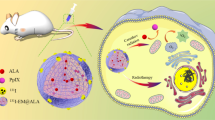Summary
To evaluate whether administration of pheophorbide-a, a new photosensitizer, followed by use of Q-switched Nd:YAG Laser produces a photodynamic reaction, we administered pheophorbide-a to female nude mice (BALB/c-nu) that had been implanted with human hepatocellular carcinoma. Intra-tumoral concentrations of pheophorbide-a were measured by high-performance liquid chromatography. 3 hours after peroral administration of 1 mg/kg body weight, the intra-tumoral concentration was too low to reveal photodynamic effects. Peroral administration of 250 mg/kg body weight, intra-peritoneal administraion of 5 mg/kg body weight, and intra-tumoral injection of 200 μg yielded 0.24 μg/g, 0.83 μg/g and 3.68-108 μg/g tumor concentrations, respectively. All tumors were irradiated interstitially using a Q-switched Nd:YAG Laser at 1064 nm. Only tumors that had been intra-tumorally injected had areas of necrosis larger than those in control tumors. The results suggest that the injection of pheophorbide-a followed by interstitial irradiation using a Q-switched Nd: YAG Laser does not induce sufficient photodynamic reaction if the intratumoral pheophorbide-a concentration is less than 0.83 μglg tumor tissue, and that photodynamic therapy may be useful if the pheophorbide-a tumor concentration is within the range of 0.83-108 μg/g.
Similar content being viewed by others
References
Dougherty TJ, Grindey GB, Fiel R, et al: Photoradiation therapy. II. Cure of animal tumors with hematoporphyrin and light. JNCI 1975;55:115–121.
Dougherty TJ, Kaufman JE, Goldfarb A, et al: Photoradiation therapy for the treatment of malignant tumors. Cancer Res 1978:38:2628–2635.
Lipson RL, Baldes EJ, Olsen AM: The use of a derivative of hematoporphyrin in tumor detection. JNCI 1961:26:1–11.
Lipson RL, Baldes EJ, Gray MJ: Hematoporphyrin derivative for detection and management of cancer. Cancer 1967:20:2255–2257.
Dougherty TJ, Thoma RE, Boyle DG, et al: Interstitial photoradiation therapy for primary solid tumors in pet cats and dogs. Cancer Res 1981:41:401–404.
Bown SG, Tralau CJ, Coleridge SPD, et al: Photodynamic therapy with porphyrin and phthalocyanine sensitization: Quantitative studies in normal rat liver. Br J Cancer 1986:54:43–52.
Dougherty TJ: Photodynamic therapy. In: Kessel D, ed. Methods in Porphyrin Photosensitization. Plenum Press, New York. 1985:313–328.
Segelman AB, Hagen IK, Chernomorsky SA, et al: Highly purified pheophorbide a as a photosensitizer in human bladder carcinoma in vitro. SPIE 1987:847:205–209.
Roder B: Pheophorbide a-A new photosensitizer for the photodynamic therapy of tumors. Stud Biophysi 1986:114:183–186.
Maeda N, Ichikawa K, Mizuno N: Comparison of anti-tumor effect by photoradiation therapy with pheophorbide a and hematoporphyrin derivatives against the chemically induced rat skin tumors. Photomed Photobiol 1986:8:35–36.
Mashiko S, Sato S, Inaba H, et al: Basic study on photochemical effect of pheophorbide a irradiated by Nd:YAG Laser light. J Jpn Soc Laser Med 1986:6:113–116.
Fujishima I, Sakai T, Tanaka T, et al: Photodynamic therapy using pheophorbide-A and Nd:YAG Laser (acoustic Q switch). J Jpn Soc Laser Med 1987:8:57–58.
Ina K, Tsuneawa H, Sugihara M, et al: Studies on Laserthermia and PDT using Nd:YAG Laser. SPIE 1989:1066:192–196.
Suzuki S, Aoki J, Shiina Y, et al: Experimental studies of endoscopie local hyperthermia with contact Nd:YAG Laser. SPIE 1987:712:15–21.
Clare NT: The work of the biochemical section, Ruakura animal research station. J New Zealand Inst Chem 1953:17:57–76.
Ciare NT: Photosensitization in animals. Advanc In Vet Sci 1955:2:182–211.
Hashimoto Y, Naito K, Tsutsumi J: Photosensitization of animals by the viscera of abalones, Haliotis spp. Bull Jpn Soc Sci Fish 1960:26:1216–1221.
Hashimoto Y, Tsutsumi J: Isolation of a photodynamic agent from the liver of abalone, Haliotis discus hannai. Bull Jpn Soc Sci Fish 1961:27:859–866.
Tsutsumi J, Hashimoto Y: Isolation of Pyrophcophorbide a as a photodynamic pigment from the liver of abalone, Haliotis discus hannai. Agr Biol Chem 1964:28:467–470.
Gatenby RA, Hammond ND, Brown DQ: Tumor therapy with hematoporphyrin derivative and lasers via a percutaneous fiberoptic technique: preclinical experiments. Radiology 1987:163: 167–171.
Author information
Authors and Affiliations
Rights and permissions
About this article
Cite this article
Yamashita, Y., Moriyasu, F., Ono, S. et al. Photodynamic therapy using pheophorbide-a and Q-switched Nd:YAG Laser on implanted human hepatocellular carcinoma. Gastroenterol Jpn 26, 623–627 (1991). https://doi.org/10.1007/BF02781679
Received:
Accepted:
Issue Date:
DOI: https://doi.org/10.1007/BF02781679




